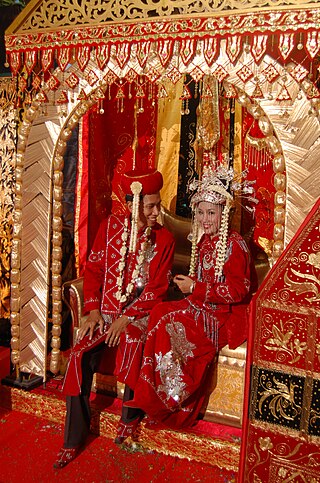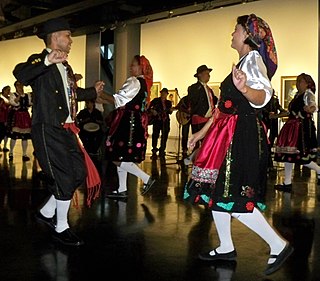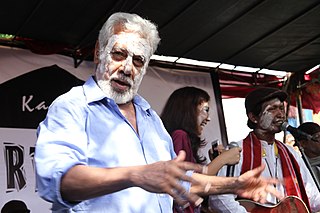
Portuguese creoles are creole languages which have Portuguese as their substantial lexifier. The most widely-spoken creoles influenced by Portuguese are Cape Verdean Creole, Guinea-Bissau Creole and Papiamento.
Negerhollands ('Negro-Dutch') was a Dutch-based creole language that was spoken in the Danish West Indies, now known as the U.S. Virgin Islands. Dutch was its superstrate language with Danish, English, French, Spanish, and African elements incorporated. Notwithstanding its name, Negerhollands drew primarily from the Zeelandic rather than the Hollandic dialect of Dutch.

Betawi people, or Batavians, are an Austronesian ethnic group native to the city of Jakarta and its immediate outskirts, as such often described as the native inhabitants of the city. They are the descendants of the people who inhabited Batavia from the 17th century onwards.

The Kristang or Serani are a creole ethnic group of people of predominantly mixed Portuguese and Malaccan descent, with substantial Dutch, British, Jewish, Malay, Chinese and Indian heritage. They are based in Malaysia and to some extent in Singapore. People of this ethnicity have, besides Portuguese, a strong Dutch heritage due to intermarriages, which is common among the Kristang. In addition, due to persecution by the Portuguese Inquisition in the region, a lot of the Jews of Malacca assimilated into the Kristang community. The creole group arose in Malacca between the 16th and 17th centuries, when the city was a port and base of the Portuguese Empire. Some descendants speak a distinctive Kristang language or Malacca Portuguese, a creole based on Portuguese. Today the government classifies them as Portuguese Eurasians.

The Mardijker people refer to an ethnic community in the Dutch East Indies made up of descendants of freed slaves. They could be found at all major trading posts in the East Indies. They were mostly Christian, of various ethnicities from conquered Portuguese and Spanish territories, and some with European ancestry. They spoke Mardijker Creole, a Portuguese-based creole, which has influenced the modern Indonesian language.
Petjo, also known as Petjoh, Petjok, Pecok, Petjoek is a Dutch-based creole language that originated among the Indos, people of mixed Dutch and Indonesian ancestry in the former Dutch East Indies. The language has influences from Dutch and then depending on the region Javanese, Malay, Sundanese and Betawi. Its speakers presently live mostly in Indonesia and the Netherlands. The language is expected to become gradually extinct by the end of the 21st century, due to Indos' shift toward Indonesian in Indonesia and Dutch in the Netherlands.

Kroncong is the name of a ukulele-like instrument and an Indonesian musical style that typically makes use of the kroncong. A kroncong orchestra or ensemble traditionally consists of a flute, a violin, at least one, but usually a pair of kroncongs, a cello in Pizzicato style, string bass in pizzicato style, and a vocalist. Kroncong originated as an adaptation of a Portuguese musical tradition, brought by sailors to Indonesian port cities in the 16th century. By the late 19th century, kroncong reached popular music status throughout the Indonesian archipelago.
Koja is a district of North Jakarta, Indonesia. It is known as the location of Kampung Tugu, a historic Portuguese-influenced neighborhood in North Jakarta.
Betawi, also known as Betawi Malay, Jakartan Malay, or Batavian Malay is the spoken language of the Betawi people in Jakarta, Indonesia. It is the native language of perhaps 5 million people; a precise number is difficult to determine due to the vague use of the name.
The Gorontalo language is a language spoken in Gorontalo Province, Sulawesi, Indonesia by the Gorontalo people.

The Portuguese were the first Europeans to establish a colonial presence in the Indonesian Archipelago. Their quest to dominate the source of the spices that sustained the lucrative spice trade in the early 16th century, along with missionary efforts by Roman Catholic orders, saw the establishment of trading posts and forts, and left behind a Portuguese cultural element that remains in modern-day Indonesia.

Indo people are a Eurasian people of mixed Asian and European descent. Through the 16th-18th centuries, they were known by the name Mestiço. To this day, they form one of the largest Eurasian communities in the world. The early beginning of this community started with the arrival of Portuguese traders in South East Asia in the 16th century. The second large wave started with the arrival of the Dutch East India Company (VOC) employees in the 17th century and throughout the 18th century. Even though the VOC is often considered a state within a state, formal colonisation by the Dutch only commenced in the 19th century.

Portuguese Indonesians are native Indonesians with Portuguese ancestry or have had adopted Portuguese customs and some practices such as religion.
Tugu Church, is a Protestant church in Kampung Kurus, Semper Barat Administrative Village, Cilincing, Jakarta, Indonesia. The church was located in Kampung Tugu, a village of Mardijker people, a Creole Portuguese community. It is the second oldest church in Jakarta, after Sion Church

Kampung Tugu is a historical neighborhood located in the northwestern Jakarta in the island of Java. Kampung Tugu grew from the land granted by the government of the Dutch East Indies to the converted Mardijker people in the 17th century. From this land, a Christian settlement grew and developed its own culture. Kampung Tugu is one of the oldest Christian neighborhoods in the western part of Indonesia. Today, the Christian neighborhood of Kampung Tugu is part of the Administrative Village of Tugu in Koja Subdistrict of North Jakarta, Indonesia.

Het kasteel van Batavia is a 17th-century painting by the Dutch painter Andries Beeckman. The painting depicts the Batavia Castle, the headquarter of the Dutch East India Company located in what is now Kota Tua in Jakarta, Indonesia. The painting is currently displayed in the Rijksmuseum in Amsterdam.
Parada Harahap was an important journalist and writer from the late colonial period and early independence era in Indonesia. In the 1930s, he was called the "king of the Java press". He pioneered a new kind of politically neutral Malay language newspaper in the 1930s which would cater to the rising middle class of the Indies.

Jong Batak Bond, sometimes simply called Jong Batak, was a short-lived but influential Batak intellectual organization founded in Batavia, Dutch East Indies in December 1925. Like Budi Utomo, Jong Java and other such organizations, its members consisted of native Indonesian students in Dutch-language schools interested in advancing their ethnic group and Indonesian nationalism at the same time. Notable members of the group include Amir Sjarifuddin Harahap, Todung Sutan Gunung Mulia Harahap, Sanusi Pane, Saleh Said Harahap and Arifin Harahap.

Christiaan Hendrik "Hein" Eersel was a Surinamese linguist and cultural researcher.











